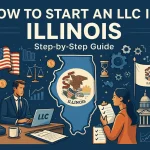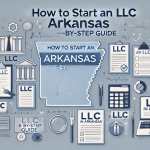When you start an LLC, one of the big questions is how it will be taxed. The good news is that LLCs have flexible and relatively simple tax options compared to traditional corporations. By default, an LLC is not taxed as a separate business entity at the federal level. Instead, it’s treated as a “pass-through” entity, meaning the profits or losses of the business pass through to the owners’ personal tax returns. But what does that mean in practice for single-member vs multi-member LLCs? And what about self-employment taxes or special tax elections like S-Corps?
In this guide, we’ll walk you through the basics of LLC taxation so you can understand what to expect when tax season rolls around.
Pass-Through Taxation: The Default for LLCs
By default, the IRS does not recognize an LLC as a distinct taxable entity. Instead, the IRS “disregards” the entity for tax purposes and taxes the owners directly:
- If you have a single-member LLC, the IRS automatically treats it like a sole proprietorship. This means you don’t file a separate federal tax return for the LLC. Instead, you report the LLC’s income and expenses on your personal tax return (Form 1040), typically on Schedule C (Profit or Loss from Business). In the IRS’s eyes, you and the business are one and the same for tax filing purposes (even though legally the LLC is separate).
- If you have a multi-member LLC (i.e., an LLC with two or more owners), the IRS by default treats it like a partnership. The LLC will need to file an informational partnership tax return (Form 1065) each year. This return reports the total income and expenses of the business. Along with Form 1065, the LLC issues Schedule K-1 forms to each member, which break down each member’s share of the profits or losses. The members then report that income on their personal tax returns (often on Schedule E for supplemental income). The LLC itself generally doesn’t pay federal income tax directly.
This setup is known as pass-through taxation because the business’s taxable income passes through to the owners. It avoids the “double taxation” scenario that C-corporations face (where the corporation pays tax on its profits, and then shareholders pay tax again on dividends). With an LLC, the profit is only taxed once — on the owners’ returns.
Taxes for LLC Owners: Income Tax and Self-Employment Tax
If you’re an LLC owner, how do you actually pay taxes on the income? Here’s what to expect:
- Income Tax: As mentioned, the income passes through to you. You’ll include the LLC’s profit on your personal tax return and pay income tax based on your individual tax bracket. If the LLC had a loss, that can potentially offset other income on your return (subject to certain rules and limitations).
- Self-Employment Tax: One aspect that often surprises new LLC owners is self-employment tax. If you actively work in your LLC (which is true for most small business owners), the IRS considers you self-employed, not an employee of your LLC (unless you’ve made a special tax election which we’ll discuss later). This means you’re responsible for self-employment taxes, which cover Social Security and Medicare contributions. As of now, the self-employment tax rate is 15.3% on your net self-employment income (roughly, your share of LLC profit), which covers both the employer and employee portions of Social Security and Medicare.
- For a single-member LLC, all the business’s net profit is typically considered self-employment income (except certain types of passive income like rental income or investment income which might not be subject to SE tax).
- For a multi-member LLC, each member’s share of the profit is generally subject to self-employment tax, if that member is actively involved in the business (a “materially participating” member). If a member is more of a passive investor and not active, there may be different tax treatment, but that gets into complex territory.
- State Income Tax: Don’t forget, you might also pay state income tax on your LLC profits, depending on your state’s tax laws. Pass-through business income is usually taxed at the state level on your personal return just like any other income.
It’s wise to set aside a portion of your profits for taxes throughout the year (often around 25-30%, depending on your total income and tax bracket). LLC owners typically pay quarterly estimated taxes to the IRS and possibly to their state to cover income and self-employment taxes, since no employer is withholding taxes for you.
Federal Tax Forms and Filing for LLCs
Here’s a quick recap of the typical federal tax forms for LLCs under default taxation:
- Single-member LLC: No separate business return. Use Schedule C (or Schedule E/F for rental/farm income if applicable) with your Form 1040. Also file a Schedule SE to calculate self-employment tax if you have net profit.
- Multi-member LLC: File Form 1065 (Partnership Return) for the LLC. Provide Schedule K-1 to each member. Each member then reports their K-1 amounts on their own Form 1040 (usually on Schedule E). Members with self-employment income from the K-1 will file a Schedule SE as well.
- Employer Identification Number (EIN): Make sure your LLC has an EIN (Employer ID Number) from the IRS, which is like the business’s Social Security number. You’ll use it when filing these tax forms and for things like opening a bank account. (If you followed the steps in our LLC formation guide, you likely obtained an EIN as part of setting up your LLC). If not, you can get one from the IRS online for free.
Keep in mind, the LLC itself might still need to file certain forms even if it doesn’t pay tax. For example, the partnership return for a multi-member LLC is required by the IRS to detail the earnings and distributions.
Optional: Electing S-Corp Status for Your LLC
One of the great features of an LLC is that you’re not stuck with the default tax classification. You have the ability to elect a different tax status if it benefits you. The most common switch is electing to have your LLC taxed as an S-Corporation (S-Corp) for tax purposes.
Why would you do this? In a word: taxes. Remember that self-employment tax we talked about? If your LLC’s profits are relatively high, that 15.3% on everything can become a big chunk of money. With an S-Corp, you can potentially reduce the amount of profit subject to self-employment taxes:
- In an S-Corp, owners who work in the business are considered employees for tax purposes. The S-Corp pays them a salary (which is subject to Social Security/Medicare tax, split between employee and employer portions). Any additional profit beyond the salaries is distributed as dividends to the owners, and those dividends are not subject to Social Security/Medicare taxes.
- The trick is that the IRS requires the salary to be “reasonable compensation” for the work done. You can’t just pay yourself a ridiculously low salary to dodge taxes. But if your LLC is making, say, $100,000 in profit per year and you could reasonably pay yourself a $50,000 salary, then on the remaining $50,000 distribution you wouldn’t owe the 15.3% self-employment tax – potentially saving around $7,650 in taxes.
However, electing S-Corp status means more complexity:
- You’ll have to run payroll for yourself (and any co-owners working in the business), which means additional paperwork and possibly payroll services.
- The LLC (as an S-Corp) would file a corporate tax return, Form 1120-S, and issue K-1s to owners, instead of the partnership return or Schedule C.
- Some states charge specific taxes or fees on S-Corps.
- Not all LLCs can elect S-Corp; there are restrictions (for example, you generally can’t have more than 100 owners, and owners must be U.S. persons in most cases).
Despite the added complexity, many small business LLCs switch to S-Corp taxation when their profits grow to a point where the tax savings outweigh the costs of the extra work. It’s often a good idea to consult with an accountant to run the numbers – typically, once your net income (after expenses) is in the ballpark of, say, $40,000-$60,000 or more, it’s worth investigating the S-Corp option. Below that, the savings might be minimal or not worth the hassle.
If you decide to make the switch, you do so by filing Form 2553 with the IRS (usually by March 15th of the year you want it to be effective). Some LLC formation services or accountants can help file this form when the time comes.
Other Tax Considerations
- State-Specific Taxes: Be aware that some states impose additional taxes or fees on LLCs. For example, California charges an $800 annual franchise tax on LLCs (regardless of profit) plus an extra fee for LLCs with income over a certain amount. Other states might have annual report fees or franchise taxes. Always check your state’s requirements so you’re not caught off guard.
- Local Taxes: Depending on your locale, there might be local business taxes (like a gross receipts tax or city business tax). Again, this varies, but as an LLC owner you should check city and county requirements.
- Sales Tax & Payroll Tax: Separately from income taxes, if your LLC sells products (or certain services) you may need to collect sales tax and remit it to the state. And if you have employees (including if you start treating yourself as an employee under an S-Corp), you’ll have to deal with payroll taxes. These are beyond the scope of how LLC income is taxed, but they’re part of the overall tax picture of running a business.
- Deductible Business Expenses: Remember that as an LLC owner, you should take all the business deductions you’re entitled to. Your taxable income (and thus your tax) is based on profit (income minus expenses). Common deductions include equipment, office supplies, travel for business, a home office (if you qualify), and professional services. Keeping good records throughout the year will ensure you don’t miss out on these.
Conclusion:
LLCs offer a lot of flexibility, and that includes how they’re taxed. By default, you get the simplicity of pass-through taxation — meaning less paperwork and no corporate-level tax. Most small business owners find this default setup straightforward and cost-effective. As your business grows, you also have the option to explore other tax treatments, like the S-Corp election, to optimize your tax situation.
The key things to remember: if you’re a single-member LLC, plan to file your taxes much like a sole proprietor would. If you’re a multi-member LLC, prepare for a partnership-style tax filing. In both cases, be ready to handle self-employment taxes on your earnings. And always keep an eye on your state’s specific tax rules for LLCs to stay compliant.
Taxes can be complex, especially as your business expands. It’s often helpful to consult with a CPA or tax professional who has experience with small businesses and LLCs. They can provide personalized advice on what’s best for your situation. But with the basics from this guide, you now have a solid understanding of how LLCs are taxed and can approach your first tax season with more confidence.
If you’re still in the process of starting your LLC, make sure to get your EIN and set up a good bookkeeping system early on — these steps (covered in our formation resources) will make handling your LLC’s taxes much smoother. With a little preparation and the right knowledge, you’ll master the art of LLC taxes in no time.














